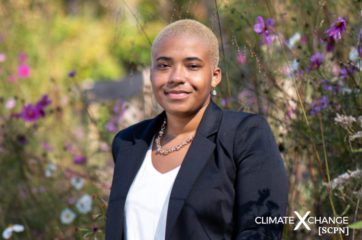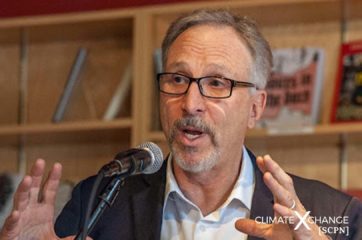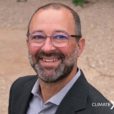All across the country, members of our State Climate Policy Network (SCPN) are fighting to make an impact on climate change in their communities. We have individuals in our Network from all 50 states, each experiencing climate change differently in their local areas and finding unique solutions to build resiliency efforts.
Jerilyn Lopez Mendoza is an environmental lawyer and advocate with over 20 years of service to the field. From working for various federal and state agencies to nonprofit and private industries, Mendoza has contributed to the development of legislation and infrastructure to tackle the role of environmental injustices for various communities. Here, we discuss her previous and current roles and also dive into her experience being a woman of color within the climate space.
This interview has been lightly edited for clarity and brevity.
Kortni Washington: To start, can you briefly touch upon any sort of current positions you may hold?
Jerilyn Lopez Mendoza: I’m currently working as the Los Angeles Regional Organizer for a nonprofit called the Climate Center, which is based in Santa Rosa, and has been around for about 20 years. They were very instrumental in the choice aspect of energy, the CCA (Community Choice Aggregation) development that occurred statewide. Then, almost two years ago, they turned their attention to more statewide initiatives, where they’re working on statewide policy initiatives as well as legislation. I’m the only staff member in Los Angeles and was just hired in April. I’ve only been on board for about four months, and I’m the first employee in Southern California, so it’s very exciting.
Kortni Washington: It sounds very exciting, especially with the emphasis on statewide policy which the State Climate Policy Network, the program I’m currently a part of, has a lot of emphasis on too. I think it’s very neglected, honestly, when it comes to climate movements, to focus on statewide policy. A lot of the effort is more towards the federal level, so it’s nice to see that there are people on the ground doing the work to get their states more environmentally conscious, and I really appreciate that.
Jerilyn Lopez Mendoza: We’re seeing the impacts in California in terms of there really not being a wildfire season anymore. We had wildfires in the winter. We’re dealing with power safety, our power being shut off. The public safety power shuts off from the investor-owned utilities as a way to cut down on fire risk, and those were occurring at Thanksgiving time in November. So, we’re really seeing the tangible impacts of climate change in California in a very real way. I’m hoping that leads to action from our legislators and our policymakers on a statewide level.
Kortni Washington: Have you always been interested in working in the climate space? What was your initial incident or opportunity that brought you into working towards climate justice?
Jerilyn Lopez Mendoza: There were a couple of catalyzing events for me. When I went to law school, I did so with the intention of working on environmental justice issues. That was after I had consulted with a lot of people in the environmental advocacy community in the Bay Area and in Southern California, and they all said we need more lawyers — this was back in the mid-90s. So, I went to law school with the intention of focusing my work on environmental justice battles once I graduated and passed the bar. At that time, our focus in Los Angeles, which is where I was working, was on reducing exposure to toxins and increasing green space. By increasing green space, we could both improve the quality of life for people who lived in the urban core as well as try to lower the impact of the heat island effect.
There were some very tangible things that we were trying to accomplish with increasing green space, but reducing exposure to toxins was more related to criteria air pollutants, particularly diesel exhaust, which is characterized as a carcinogen. It wasn’t really a focus on climate per se, but a focus on lessening the impacts of general environmental degradation on disadvantaged communities.
Then, in 2006, I saw An Inconvenient Truth, which is the movie that Al Gore made about the climate impacts that we were experiencing worldwide. That was both eye-opening, in terms of raising my consciousness about the issue of climate, as well as terrifying, because it showed how quickly the world was changing as a result of higher temperatures specifically related to the human generation of greenhouse gases, worldwide, and what those impacts were already having on the snowpacks in Antarctica. What [climate change] was doing to animals. Worldwide, what the devastation of the Amazon rainforest was doing in terms of decreasing its ability to serve as sort of the lungs of the hemisphere. I mean, there were some very big picture issues that were painted by that movie. From that point, my interest was really engaged in what this meant for us on the ground. These big picture items that were articulated in the movie, how do we live with the impacts that are going to be occurring on the ground in our neighborhoods and our communities here in Southern California?
The next year, I was asked if we hypothetically had money from cap-and-trade — which was not yet implemented in California — how they could be utilized in disadvantaged communities. I was able to hire an intern who was also an attorney and asked her to talk to all of the different environmental and social justice activists in Los Angeles to come up with some specific ideas that could lessen climate impacts. By utilizing funds that would be available through cap-and-trade, we ended up creating a 70-slide PowerPoint that had all the different ideas that folks had. Everything from creating paint that could serve as solar panels and generate solar power, to things like expanding tree canopy to reduce the heat island effects in places like South Los Angeles and other places that were really suffering from a lack of green space. This also included figuring out how to have renters, people who are tenants as opposed to homeowners, take advantage of renewable energy sources even if they weren’t able to own those sources.
There was a lot of really great brainstorming that we did in 2007 that we were able to share with some of the elected officials that we knew, and we also shared it with the people who had participated with us in that endeavor. Then, my career took a number of different turns. I served as an appointed government official at the Port of Los Angeles as well as at the Board of Public Works for the City of Los Angeles. I’ve worked with a couple of different utilities. I also worked at a couple of different nonprofits, and there were two other catalyzing events, in addition to An Inconvenient Truth. The second was when I worked with an organization called ICLEI, the International Council for Local Environmental Initiative, which is an organization that partners with the United Nations to help local municipalities calculate their greenhouse gas (GHG) emissions, figure out what their impact on the environment is, and then try to reduce GHG production and reduce their reliance on fossil fuels. It was a very eye-opening experience to be their California manager because there were all these small cities in the state of California.
They were interested in documenting where their GHGs were coming from, and then once they had a sense of what their GHG production was, how could they change their procurement policies so that they would be reducing those impacts if we gave them tools that they could use with just the support of an intern. They didn’t need a staff person because a lot of smaller cities and counties don’t have a lot of bandwidth or capacity to do this kind of work. But, we were able to help them calculate both their GHG footprint, and then help them make wiser choices and their procurement processes to reduce their impacts.
Through this process, a lot of those cities and counties started passing more regulations, saying, ‘Okay, when we turn over our fleet, instead of relying on diesel fuel, we’re going to try to get electric vehicles, or whatever is the cleanest possible vehicles that are available when we’re ready to spend that money.’ It was really eye-opening to see cities from Sonoma County, San Diego County, and LA County really start to think deeply about how the choices they were making were having an impact on the environment. Two years ago, they were thinking about those impacts, and how we as communities need to prepare each other and ourselves to be resilient to these things because it’s too late for [complete] mitigation. It’s too late to try to stop these impacts from happening, what we have to do is prepare for their inevitability.
Kortni Washington: We’ve spent so much time kind of thinking about, or even questioning if there’s a climate crisis, and now we’re at the point that it’s here and we need to make sure that people are prepared. You bring a really unique perspective to climate justice as your background is in law. I’m also interested in using the law for environmental justice. How can or how have you used the law to bring change within the field of environmental justice?
Jerilyn Lopez Mendoza: One of the big ways that I used legal tools to try to positively impact environmental justice was through the use of what’s called Community Benefit Agreements. The idea of a Community Benefit Agreement is that when somebody wants to build a project, they come to the community, make these promises, and we codify those commitments. We make concrete commitments — from job training to housing to environmental mitigation — and we actually put it in an agreement that says, okay, developer, you say there’s going to be this many jobs, there’s going to be this many benefits to the community. Here’s what we’re putting in writing. We, as coalition members or community members and stakeholders, will sign this agreement. If you sign this agreement, we agree to cooperate and not oppose your project, if you agree that all of these things, all these commitments, will be met. Then there’s a community benefit that is specifically built into the project that we can then enforce through contract law. It’s not some pie in the sky promise, it is a concrete commitment in a contract that, if you then don’t deliver, we can take you to court and force you to deliver. We’re not going to sue you for money, we’re going to sue you to get those jobs that you said you were going to give us, and we’re going to sue you for that mitigation of environmental impacts that you said you were going to do.
Unlike the California Environmental Quality Act — where developers can make commitments to mitigation but if later on, it proves to be too expensive, then they don’t have to do it — this locks them in by a contract cooperation agreement, and a Community Benefits Agreement, in a way that gives the community stakeholders a sense of confidence and a sense of building trust that they will indeed keep their promises. I’ve used that in coalition with a number of other stakeholders around the expansion of the Staples Center, where the Lakers and the WNBA Sparks play, as well as the Clippers and the Kings. We signed the Community Benefits Agreement back in 2002 that did include affordable housing, job training, job hiring, and environmental mitigation commitments. That served to be very, very useful for people who were living and working in the community and actually did get to see those benefits.
Then, we did it again in 2004 around the expansion and modernization of Los Angeles International Airport. In that particular instance, the number of benefits that we were able to negotiate with Los Angeles World Airports added to up to half a billion dollars worth of community benefits. Everything from an asthma van that would be used to help detect and diagnose asthma in the community surrounding the airport and the weatherization of schools at Inglewood and Lennox school districts, to getting them to agree to get the planes to not run on their fuel while they were in the actual gate but actually instead run on electric power, which is much cleaner. We negotiated over about a year and a half. With about 19 different organizations signing on, it added up to $500 million.
That’s one of the things that I think I’ve helped contribute both to the environmental justice world as well as to general social justice, as a way to win.
Kortni Washington: It’s nice to know that there’s some sort of legal infrastructure that offers protection and doesn’t require you to necessarily sue or go to court; but instead, from the beginning, explicitly stating what the community should get from this, what jobs they should bring in from this, and so on. From what you’ve demonstrated, you have more than a wealth of experience in both the private and nonprofit spaces as well as the public sector, from working in law firms, government agencies, and finally as an organizer with a climate nonprofit. What have been some of your biggest challenges in passing climate efforts in both sectors, as well as what are some of the benefits from working in different sectors?
Jerilyn Lopez Mendoza: I’ll start specifically from a governmental perspective because, as I mentioned, I was a volunteer appointed official by Mayor Villaraigosa at the Port of Los Angeles, where I was a Harbor Commissioner for five years. Then, I was a paid commissioner on the Board of Public Works for three years.
One of the things that you can accomplish as a government official, either as an elected or in my case an appointed official, is that you can provide the political will to do the right thing. In that regard, if you have the support of the elected official who appointed you, which we did in both instances, and you have colleagues that trust that you know what you’re doing, you’re able to accomplish huge things with support from community stakeholders, residents, environmental justice advocates, unions, and whoever’s part of the stakeholder community. When I was Harbor Commissioner, we were able to pass the first-ever clean air action plan to reduce diesel pollution from all port sources. That included ocean-going vessels, smaller vessels, such as tugboats, trains, on-dock equipment, and trucks. That was huge, and it was something we did in collaboration with the Port of Long Beach, and it took about a year for us to get it going. That clean air action plan has been replicated all over the world as a way to reduce impacts on human health surrounding ports all over the world. That’s something that we could not have done if Mayor Villaraigosa had not come to the commissioners and said, ‘I want this port to be the cleanest and greenest in the world.’ Because he said that, we had the ability to move forward with the clean air action plan, even though we got a lot of resistance from private actors who thought it would be too expensive. In fact, it was very successful; and in the first four years of its operation, we managed to reduce diesel pollution at the port by about 80%. That’s one of the benefits of being in government, especially in leadership — you can do those types of things with the support of constituents and stakeholders on the ground in a way that you can’t if you’re an advocate looking in, so to speak. At the same time, you’re a little bit limited because you have to be careful that you’re reflecting the goals, objectives, and values of the elected official who appointed you. If you have differing opinions, you have to censor yourself a little bit, and that can be very difficult.
One of the things that are incredibly inspirational and motivational about being an advocate is that you know you’re speaking on behalf of stakeholders who care deeply about the issues that you’re working on. I feel like I can use my voice in a stronger way, in a more passionate way, and try to be more persuasive with my arguments because I’m speaking as an advocate on behalf of those who perhaps don’t have a voice. Or, they speak another language, so they don’t have all the information that they need. It’s just shameful that in this day and age, in the 21st century, we’re not respecting the diversity in the state of California enough to provide that information in a multitude of languages. But as an advocate, there is a freedom to be passionate about the work that you do and to speak truth to power in a way that you don’t have when you’re working either in the private sector or as a government official. The challenge is persuading those who are in positions of power to do the right thing, and that can sometimes be successful, and sometimes not, because they’re listening to different types of voices themselves. That’s the drawback of being an advocate, is that you have to work within this system, where you’re one voice of many.
When working in private industry, or in my case, I worked at two different investor-owned utilities — ultimately, they have shareholders that they have to keep happy. They have people who are relying on them to make money. So, the main goal and objective are to make sure that there’s a return on investment, and the financial aspect is tantamount to everything else. Even though I think private actors have a role to play, and progressive private actors can be very persuasive in terms of making arguments before elected officials to do big and important things around the environment and climate change, that’s not their main motivation. Their main motivation is money, and making money, and making sure that they’re profitable. There are other obligations that they have, for example, if you’re working for Southern California Edison and you’re talking to the California Public Utilities Commission about anything related to your rates, your ratepayers. Everything you do has to be just and reasonable. You do have some accountability there, but ultimately you have to answer to your shareholders, and that makes it very different in terms of what the motivations and goals, and objectives are.
Kortni Washington: One thing I want to highlight and speak more about was, as you are a woman of color in these spaces that are dominated by primarily white men, what have been some other challenges or some perspective you’ve gained in navigating certain situations where this may be a barrier?
Jerilyn Lopez Mendoza: It’s interesting because the challenges that I’ve had have been across the board — in advocacy, government work, and private practice. The challenges have been consistent in terms of feeling like, sometimes my opinions or my knowledge is downplayed because I’m a woman, because I am Chicana, because I am from California. In some cases even because I was not a thin person. There are lots of different filters that people have between me and what I’m saying. There have been times when I went to events, for example, as a government official, and I didn’t know anybody, and so people would ignore me. I would go off in the corner, get some iced tea, and drink in the corner. Then a friend would come in and say, ‘oh, Commissioner, what are you doing over here in the corner?’ Suddenly everybody was interested in talking to me because when I first walked in they would see an overweight, older woman. And suddenly I was looking at them with different glasses. I was a commissioner, I was somebody in power, I was somebody of note. It was always fascinating to me who suddenly came up to me and wanted to be introduced to someone, who previously had ignored my existence.
It definitely came to a head when I worked in the Environmental Defense Fund in two different ways. One had to do with just who I was and what my identity was within the Environmental Defense Fund, and it had to do with the lack of diversity among the program staff and among the leadership and the executive team. There was just no diversity at all, and very little on the board. There would be times I’d be in meetings and I look around and I was the only person of color in the room. It’s very hard sometimes to be as open and honest as I want to be because I didn’t feel that I was altogether welcome. I didn’t feel I had allies who looked and sounded like me, and who would understand my perspective. But the other challenge I had at EDF was that the work that I was doing on environmental justice was very unique within the organization. It was an Environmental Justice Project Office in Los Angeles, and the work we were doing in LA, nobody else was doing anywhere else in the country. It was very alienating, and it was exhausting, and ultimately was the reason that I left after nine years. I felt like I was not a good fit for EDF, as an individual, given who I was and what my personal experiences had been, and also the work that I was doing was so different from anything they were doing, it just didn’t fit in either.
When I moved to utility work, sometimes the things that I said were, oh well, she used to be an advocate, so she always feels like she has to speak about the perspective of lower-income folks, disadvantaged folks, and people who are diverse. It’s like, yeah, that’s part of who I am. It’s part of why you hired me because I have that perspective. The fact that it wasn’t respected or valued was very alienating. It was more when people didn’t know who I was, didn’t know the title that I have. It was difficult to find my place. At the same time, once they knew that I had a title, I was treated so differently. I could never really trust if people were being honest with me because of how they treated me when they first met me. It’s very difficult. I think it’s better now.
I think organizations across the board are trying to be more sensitive to diversity and inclusion, not just in terms of lip service but in terms of actual change. But, I must say, I am jaded. I am resentful that it didn’t happen when I was a young person, and I hope that there’s a change that lasts a long time. But I’m not confident that change is imminent.
Kortni Washington: That was extremely powerful and something I can definitely relate to. I think being women of color, we feel like we’re both overqualified but seen as underqualified at the same time in all spaces. It’s really frustrating and can lead to burnout when it comes to work like this, especially when you’re pursuing any sort of social justice work.
Thank you so much for speaking about your experience. For our final question, what advice would you want to give to younger folks or anyone really who’s interested in taking a similar path or getting involved in similar work?
Jerilyn Lopez Mendoza: My biggest piece of advice is to not give up, to keep pushing, to keep fighting. When you feel overwhelmed by the task before you, whether it’s environmental justice struggles or relating to climate justice or climate change, no matter where you are, either as an advocate, a government employee, or an employee within a private industry, do not give up. The work is so important.
There are so many people who believe so strongly in the issues that we value, care about, and are working for that sometimes because we care so much, it can be exhausting. When we lose, when we have a setback when a bill that we’ve been working on gets delayed or gets vetoed, it’s very easy to fall into depression, and feel like, ‘oh my gosh, I spent so many months and so much of my time and energy on this bill, and we just had this setback.’ It’s easy to burn out. What I would recommend is that folks surround themselves with people who love and support them, whether they’re in the movement or not. To engage in self-care, because self-care is itself an act of revolution, especially for women, and to remember that you need to take a breath and just step back in to reevaluate. Okay, what went wrong? Was there something I could have done differently? If not, don’t take in that defeat and hold on to it, but let it go. Sometimes we can work as hard and as passionately, and do excellent work, and we still lose.
That would be my advice to folks who want to go into this space, is to not give up and to build into your life support networks and safety nets of people and loved ones that can catch you when you fall so that you can get up and battle again. And you can go back to work, and you can continue the work that you need to do, that you feel is your life’s work, but do it with a renewed sense of energy and commitment, and not feel defeated.









